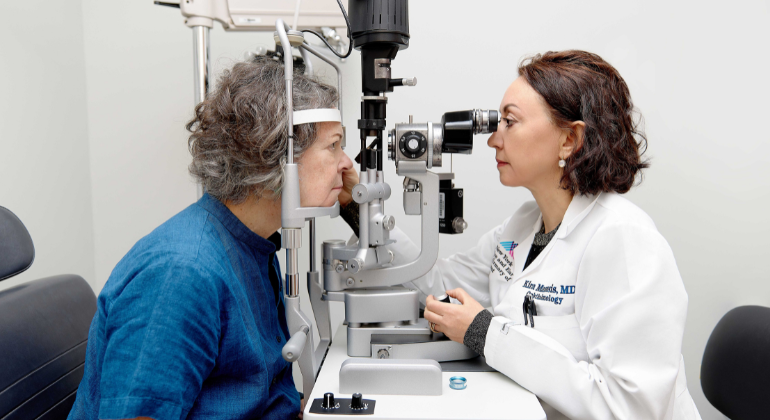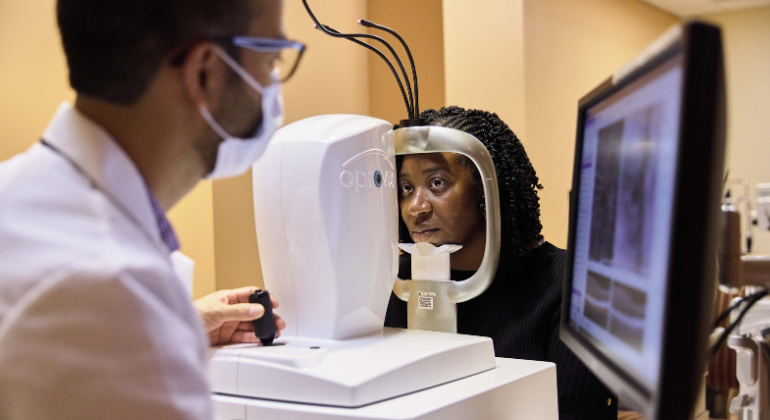January is Glaucoma Awareness Month
Mount Sinai Experts Available to Discuss Tips & Information on Degenerative Eye Disease
Glaucoma, a degenerative eye disease that causes damage to the optic nerve, is the second leading cause of blindness in the world, according to the World Health Organization. To observe Glaucoma Awareness Month, ophthalmologists at New York Eye and Ear Infirmary of Mount Sinai and the Mount Sinai Health System are offering tips for prevention and early detection of the condition.
In most cases, there are few symptoms of glaucoma. Gradually peripheral or side vision begins to worsen without patients realizing it, which enables the disease to progress into later stages.
“Glaucoma has been called the ‘silent thief of vision,’” says James C. Tsai, MD, MBA, Chair, Department of Ophthalmology, Mount Sinai Health System and President, New York Eye and Ear Infirmary of Mount Sinai. “We actually think that glaucoma is not just one disease, but a group of diseases that damage the optic nerve,” he says. “We suspect that there is a genetic predisposition, but it’s complicated — many genes have been discovered to have some association with glaucoma.”
Experts Available for Interview
- James C. Tsai, MD, MBA, Chair, Department of Ophthalmology, Mount Sinai Health System and President, New York Eye and Ear Infirmary of Mount Sinai
- Paul A. Sidoti, MD, Professor of Ophthalmology and Deputy Chair for Clinical Affairs, Department of Ophthalmology, Icahn School of Medicine at Mount Sinai and the Mount Sinai Health System
Facts about Glaucoma
- Currently, 2.7 million people in the United States over age 40 have glaucoma. The National Eye Institute projects this number will reach 4.2 million by 2030, a 58 percent increase (Glaucoma Research Foundation)
- Glaucoma costs the U.S. economy $2.86 billion every year in direct costs and productivity losses
- Glaucoma is most prevalent among African and Hispanic populations. Glaucoma is 6 to 8 times more common in African Americans than Caucasians (www.glaucoma.org)
- Risk factors include individuals over 60 years old, family history, diabetes, high blood pressure, eye injuries, and congenital defects
- Glaucoma doesn’t only impact adults. Childhood glaucoma — also referred to as congenital, pediatric, or infantile glaucoma — occurs in infants and young children. It is usually diagnosed within the first year of life
Tips for Glaucoma Prevention
- Find out if there is a history of glaucoma in your family
- Schedule routine eye examinations with an ophthalmologist to help prevent unnecessary vision loss from glaucoma and other eye conditions
- Minimize prolonged head-down positions (e.g. yoga downward positions) that some research suggests may elevate eye pressure
About the Mount Sinai Health System
Mount Sinai Health System is one of the largest academic medical systems in the New York metro area, with 48,000 employees working across seven hospitals, more than 400 outpatient practices, more than 600 research and clinical labs, a school of nursing, and a leading school of medicine and graduate education. Mount Sinai advances health for all people, everywhere, by taking on the most complex health care challenges of our time—discovering and applying new scientific learning and knowledge; developing safer, more effective treatments; educating the next generation of medical leaders and innovators; and supporting local communities by delivering high-quality care to all who need it.
Through the integration of its hospitals, labs, and schools, Mount Sinai offers comprehensive health care solutions from birth through geriatrics, leveraging innovative approaches such as artificial intelligence and informatics while keeping patients’ medical and emotional needs at the center of all treatment. The Health System includes approximately 9,000 primary and specialty care physicians and 10 free-standing joint-venture centers throughout the five boroughs of New York City, Westchester, Long Island, and Florida. Hospitals within the System are consistently ranked by Newsweek’s® “The World’s Best Smart Hospitals, Best in State Hospitals, World Best Hospitals and Best Specialty Hospitals” and by U.S. News & World Report's® “Best Hospitals” and “Best Children’s Hospitals.” The Mount Sinai Hospital is on the U.S. News & World Report® “Best Hospitals” Honor Roll for 2025-2026.
For more information, visit https://www.mountsinai.org or find Mount Sinai on Facebook, Instagram, LinkedIn, X, and YouTube.
Mount Sinai Recruits Internationally Recognized Ophthalmologists to Expand Leadership
Dec 17, 2018 View All Press ReleasesMount Sinai Establishes the Eye and Vision Research Institute
Jan 09, 2017 View All Press Releases


